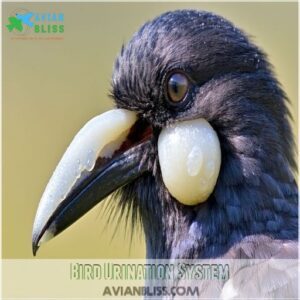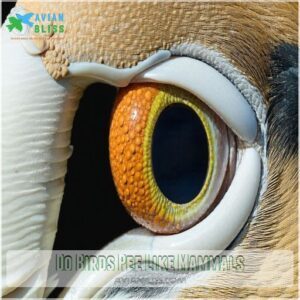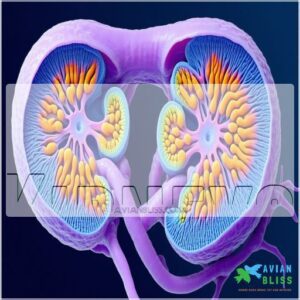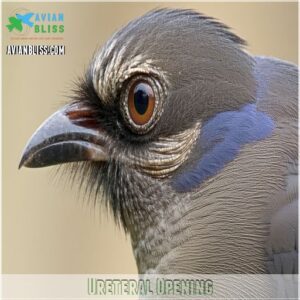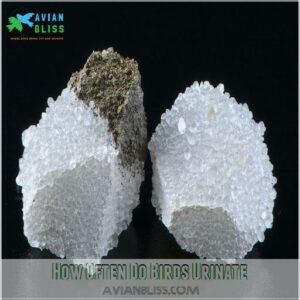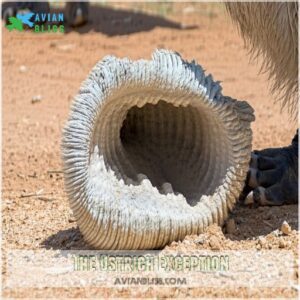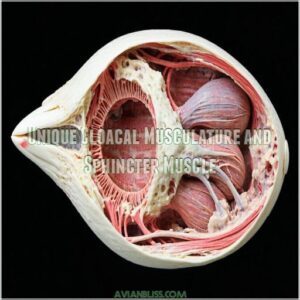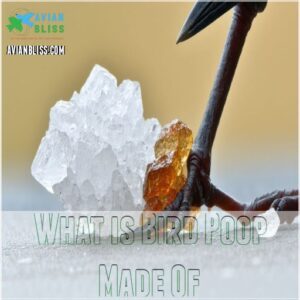This site is supported by our readers. We may earn a commission, at no cost to you, if you purchase through links.
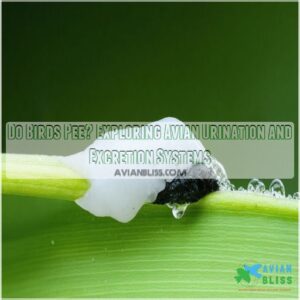
Birds don’t actually pee in liquid form – instead, they convert nitrogen waste into a white, pasty substance called uric acid.
This smart adaptation helps them stay light for flight and conserve water.
You’ll spot this as the white part in bird droppings, while the darker portion is undigested food.
Their unique system channels everything through a single exit point called the cloaca, making them incredibly efficient at processing waste.
One of the key factors contributing to their unique adaptations is their evolutionary history, which has shaped their development in ways such as the toothless advantage. There’s more to this evolutionary marvel than meets the eye, especially when you consider how different bird species have adapted their systems.
Table Of Contents
- Key Takeaways
- Bird Urination System
- Do Birds Pee Like Mammals
- Composition of Bird Urine
- How Birds Process Nitrogen
- Bird Urinary System Anatomy
- The Urination Process in Birds
- Why Do Birds Urinate Differently Than Mammals
- How Often Do Birds Urinate
- Unique Aspects of Bird Urination
- What is Bird Poop Made Of
- Frequently Asked Questions (FAQs)
- Do birds Pee and poop at the same time?
- Do birds produce Pee?
- Do birds Pee like mammals?
- How do birds urinate?
- How does bird Pee differ from mammal urine?
- Do birds Pee the same way humans do?
- Can birds control when they release waste?
- Why is bird poop sometimes different colors?
- Does bird diet affect their urine composition?
- Do baby birds process waste differently than adults?
- Can birds get urinary tract infections or kidney disease?
- Conclusion
Key Takeaways
- Unlike mammals, you won’t see birds produce liquid urine – they convert nitrogen waste into uric acid crystals, which appears as the white paste in their droppings.
- You’ll find birds don’t have a bladder – instead, they use a specialized chamber called the cloaca that combines both urine and feces before releasing them together.
- You can spot a bird’s urination frequency changing based on their diet, activity level, and water availability – they’ll excrete more often when active or well-hydrated.
- You’ll notice the white portion of bird droppings is their version of urine, while the darker part contains undigested food – this system helps them stay light for flight and conserve water.
Bird Urination System
You might wonder how birds manage their bathroom breaks without a bladder, and the answer lies in their unique urination system.
Instead of producing liquid urine, birds excrete nitrogenous waste as uric acid through a cloacal system, efficiently conserving water and keeping them light for flight.
Unique Aspects of Avian Urination
Ever wondered why you never see birds making a trip to the loo like mammals?
It’s because bird excretion is uniquely designed for efficiency, largely bypassing a bladder.
This is evident in baby birds, where a rapid waste elimination process helps maintain nest hygiene.
Instead, their cloacal system mixes waste, conserving water.
So, next time you spot bird droppings, know it’s an evolutionary marvel balancing flight convenience and survival needs.
Uric Acid Excretion
Birds have a quirky way of handling waste. Instead of urea, like mammals, they produce uric acid crystals. This method has a few cool perks:
- Water conservation: Less water needed to flush out waste.
- Evolution of uric acid: Keeps their system light.
- Uric acid toxicity: Lower risk; it’s less toxic compared to alternatives.
That’s the scoop on avian excretion!
Cloacal System
Explore the cloacal system, the multitasking marvel of avian anatomy.
Picture a Swiss Army knife of functions, where waste, reproduction, and survival meet.
Birds often use this cloaca for ingenious waste disposal and reproductive strategies, thanks to millions of years of evolution.
| Function | Evolution |
|---|---|
| Waste Disposal | Ancient Heritage |
| Reproduction | Multi-purpose Design |
| Excretion | Efficient System |
Meet nature’s clever solution—convenience at its finest!
Reduced Bladder
Speaking of the cloaca, you’ll notice birds don’t have bladders.
This lack of a bladder is a neat trick for weight reduction, boosting flight efficiency.
Think of it as nature’s built-in weight-loss program for airborne creatures.
Less weight means less energy needed for flight, and it also reduces the risk of scent trails attracting predators.
Clever, huh?
This evolutionary adaptation helps birds survive and thrive.
Do Birds Pee Like Mammals
You might wonder if birds pee like mammals, but they’ve a unique system that sets them apart.
Unlike mammals that excrete urea, birds produce uric acid, which helps them conserve water and adapt to flight.
Comparison With Mammalian Urea System
Unlike mammals who use urea for nitrogen excretion, birds rely on uric acid. This difference is like choosing between a sponge and a paper towel—birds prefer the less watery option.
- Metabolic Differences: Birds convert nitrogen to uric acid.
- Bladder-less Birds: No water-heavy storage needed.
- Evolutionary Edge: Ideal for flight and arid environments.
Water Conservation
Regarding water conservation, birds have a knack for keeping things dry in the face of arid landscapes.
Their urine, a thick paste rather than liquid, minimizes water loss—perfect for surviving in deserts.
However, certain factors such as dietary factors affecting droppings can disrupt this balance and lead to watery droppings.
By excreting uric acid instead of urea, birds reduce water usage, maintaining a fine balance between hydration and survival, ensuring they remain airborne efficiently.
Flight Adaptations
Ever wondered why birds seem perfectly suited for the skies? Their urination system plays a key role in flight adaptations:
- Weight reduction: Birds don’t carry excess water weight thanks to uric acid excretion.
- Streamlined body: No bladder keeps them aerodynamic.
- Predator avoidance: Less scent trail makes them harder to be detected.
Birds truly embody efficient flying machines!
Composition of Bird Urine
When you think about bird urine, it’s not a liquid stream like in mammals but a thick paste.
This paste-like mixture primarily consists of uric acid crystals, allowing birds to conserve precious water while disposing of waste.
Conversion of Nitrogen to Uric Acid
Birds, unlike mammals, convert nitrogen waste from amino acids into uric acid, showcasing a neat evolutionary advantage.
This twist in the nitrogen cycle makes bird urine less smelly yet fascinating.
Metabolically efficient, this process reduces water use.
So, the next time you spot a bird, remember their nitrogen waste transformation is a clever adaptation suited for their high-flying lifestyle!
The Role of Uric Acid in Water Conservation
Your bird’s body cleverly converts nitrogen into uric acid. This isn’t just any waste product; it’s a water-saving superhero! Uric acid’s less soluble than urea, meaning birds need less water to get rid of it. This is especially handy for desert birds.
In a similar vein, parent birds also engage in recycling nutrient-rich feces, which further supports their energy conservation efforts.
- Less water lost means more energy for flying.
- Avian water conservation is key to survival.
- Uric acid efficiency is a fantastic adaptation.
- Think of it as nature’s built-in water bottle.
Benefits of Uric Acid Excretion
Uric acid excretion offers several benefits for birds, helping with weight reduction and flight efficiency.
It requires less water than urea, supporting water conservation and reduced toxicity.
Amazingly, uric acid is an evolutionary advantage that doesn’t demand a bladder.
Explore these features and see why this system defines bird waste management!
| Aspect | Key Benefit | Description |
|---|---|---|
| Weight Reduction | Flight Efficiency | Less water helps birds stay light |
| Water Conservation | Bladder-Less System | Minimizes water usage |
| Reduced Toxicity | Evolutionary Edge | Uric acid handling is less harmful |
How Birds Process Nitrogen
You might be curious how birds manage the nitrogen from their protein-rich diets.
Instead of creating urea like mammals, birds transform nitrogen into uric acid, conserving water and linking their excretion methods to their reptilian ancestors.
Nitrogen Consumption From Protein
Imagine each bird meal as a spark for a high-stakes game of nitrogen balance.
Every bite taken is a step in protein metabolism, converting dietary protein into usable energy.
Here’s how it works:
- Amino acid breakdown releases nitrogen.
- This nitrogen becomes part of bird nutrition.
- The bird’s anatomy efficiently handles nitrogen waste.
Simpler than deciphering bird anatomy, right?
Conversion to Uric Acid
Converting nitrogen to uric acid is an art birds have perfected.
It’s like turning your trash into treasure.
Instead of producing urea, birds create uric acid, which is less toxic and conserves water.
This makes bird urine—and droppings—more of a dry affair, quite handy when water’s scarce.
Evolution’s quirky with uric acid formations brightening our day.
Excretion of Uric Acid Crystals
When birds need to part with waste, they excrete it in the form of uric acid crystals.
These crystals, formed from nitrogen metabolism, allow birds to conserve water, thanks to their less soluble nature.
The characteristics of these droppings, such as color and consistency, can be indicators of bird health.
This avian strategy, influenced by their unique digestive system, can cause droppings to take on various colors, including the occasional purple hue resulting from their diet consumption of certain foods, means bird droppings are often the bane of car owners everywhere, blending bird physiology with environmental impact as these waste clings to surfaces.
Shared Evolutionary History With Reptiles
Birds and reptiles share a fascinating history, if you know where to look. Here’s the scoop:
- Uric Acid Evolution: Birds and reptiles both transform nitrogen into uric acid. This evolutionary trait saves water—a smart move traced back to dinosaur lineage.
To better understand this unique process, consider using bird nitrogen products that can provide insights into avian physiology.
- Cloaca Wonder: This mutual feature handles waste.
- Amniotic Eggs: Laid by both groups, showing a nod to shared ancestors and their reptilian heritage.
Bird Urinary System Anatomy
You’ll find that a bird’s urinary system is surprisingly simple, yet efficient.
It consists of two kidneys filtering blood,
two ureters channeling waste to the cloaca—a single exit point for urine and feces—making for a streamlined design.
Kidneys
Ever wondered how birds manage without a bladder?
Their kidneys are the unsung heroes!
These tiny organs filter the blood to produce uric acid, helping birds conserve water like desert survival experts.
While they skip the mammalian bladder routine, their approach to waste management is pretty efficient.
| Aspect | Birds | Mammals |
|---|---|---|
| Waste Type | Uric Acid | Urea |
| Water Usage | Minimal | Higher |
| Storage | None (no bladder) | Bladder |
Ureters
Imagine this: after the kidneys have done their job, it’s the ureters’ turn to shine in birds. They’re the trusty tubes that connect kidneys to the cloaca, swiftly carrying that uric acid mix. Here’s why they’re fascinating:
- Structure: Thin and efficient.
- Function: Quick transport.
- Anatomy: Direct path.
These ureters keep things moving in avian species!
Cloaca
Think of the cloaca as a bird’s all-in-one waste management hub.
The ureters bring in the uric acid-rich urine, mixing it with feces for a quick exit.
It’s a quirky system that birds use to handle avian waste without a hitch.
This clever cloacal anatomy conserves water and opens the door to flight-ready adaptations.
Ureteral Opening
From the cloaca, the ureteral opening plays an interesting role in bird anatomy. Here’s why you should care:
- Location: Nestled within the cloaca.
- Function: Channels urine from kidneys, a process essential for maintaining overall avian health which can be supported by products related to the bird urinary system solutions.
- Size: Tiny but mighty.
- Evolution: Streamlined for flight efficiency over storing urine in a bladder.
Understanding these bits gives insight into how birds have adapted over time!
The Urination Process in Birds
You might think birds "pee" like mammals, but their process is quite unique.
Birds use their kidneys and cloaca to manage waste, cleverly conserving water in the process.
Urine Production
Birds aren’t just about feathers and flight—they’ve got complex systems running the show. Regarding urine production, their kidneys kick into gear, filtering blood and turning nitrogen into uric acid crystals. This setup aids water conservation, similar to how some birds, like ostriches, have unique physical features, such as eyes larger than their brains, which can be found in unusual bird facts.
Here’s a deeper look at the key players in avian urine production:
| Process | Function | Outcome |
|---|---|---|
| Bird kidney function | Filters blood | Nitrogen metabolism |
| Urea conversion | Produces uric acid | Water conservation |
| Color of bird urine | Reflects uric acid content | White appearance |
| Cloaca role | Eliminates waste | Mixed output |
| Bladder absence | Weight reduction | Better for flight |
Urine Storage
Unlike us, birds don’t have bladders! Instead, after your kidneys filter waste, uric acid crystals and other stuff travel down the ureters to a special place called the cloaca.
Here’s what happens:
- Uric acid crystals form.
- The cloaca receives urine.
- Water is reabsorbed, aiding water conservation.
- It’s a multi-purpose chamber! Amazing, right?
Elimination
You might wonder how birds handle waste elimination.
Through the cloaca, they efficiently manage bird waste disposal, blending uric acid crystals from urine with feces, forming the familiar bird droppings.
This unique cloaca function supports flight adaptations by saving weight.
The resulting bird droppings are often the subject of various products and solutions, such as those found in bird dropping products, that aim to mitigate their impact.
| Process | Waste Type | Function | Adaptation |
|---|---|---|---|
| Mixing | Uric Acid | Disposal | Weight Saving |
| Blending | Feces | Elimination | Flight Ready |
| Expulsion | Both | Efficiency | Predator Aversion |
| Mixing | Uric Acid | Waste | Water Conservation |
Water Reabsorption
After birds eliminate waste, they’ve got a nifty trick up their sleeves—water reabsorption. This process optimizes water usage and saves moisture, vital for survival, especially in arid environments.
Here’s how it works:
- Kidney function: Filters blood efficiently.
- Uric acid role: Forms paste-like droppings.
- Evolutionary twists: Adapts for drier habitats.
Why Do Birds Urinate Differently Than Mammals
You’ll find that birds don’t store urine in a bladder like mammals do, instead passing their waste through a specialized chamber called the cloaca where urine mixes with feces.
Unlike your body’s production of urea, birds convert nitrogen waste into uric acid crystals, which helps them stay lighter for flight and conserve water more efficiently.
Developmental Constraints
The evolutionary journey of birds reveals fascinating developmental constraints that shaped their unique urination system. These constraints emerged from the need to optimize flight capabilities while maintaining efficient waste management.
| Constraint Factor | Impact | Adaptation |
|---|---|---|
| Weight Reduction | No bladder needed | Immediate waste removal |
| Flight Efficiency | Streamlined body | Cloacal system |
| Water Conservation | Minimal fluid storage | Uric acid crystals |
| Metabolic Balance | Continuous processing | Quick excretion |
These adaptations showcase how birds evolved to master the skies while efficiently managing their waste elimination needs.
High Protein Diet
Birds’ protein-rich diets shape their unique urination system.
Unlike mammals that produce urea, birds convert dietary proteins into uric acid through amino acid metabolism.
This difference isn’t random – it’s perfectly suited to their high-protein lifestyle.
When birds feast on insects, seeds, or meat, their bodies efficiently process these protein-packed meals into concentrated uric acid crystals.
This system lets them maintain proper nitrogen balance while consuming a great deal more protein than most mammals, all while minimizing water loss through a remarkably efficient bird waste management process.
How Often Do Birds Urinate
You’ll notice birds release waste frequently throughout the day, as they don’t have a bladder to store urine like mammals do.
The frequency of their urination depends on several factors, including their diet, water intake, activity level, and the climate they live in.
Diet
Food choices directly influence how frequently birds relieve themselves.
You’ll notice seed-eating birds produce waste less often than those feasting on berries or insects, thanks to different digestion rates.
When birds munch on protein-rich foods, their bodies must process more amino acids, leading to increased uric acid production.
Meanwhile, nectar-sipping hummingbirds might need to excrete every 15-20 minutes to maintain their lightning-fast metabolism.
Water Availability
Water availability is a major factor in how often birds pee.
When water’s plentiful, you’ll see birds urinate more frequently compared to times of scarcity.
Desert birds have mastered water conservation, going longer between bathroom breaks by producing highly concentrated uric acid.
During droughts, birds can considerably reduce their urination frequency, though this varies by species and their natural habitat.
Activity Levels
Just like your gym routine affects how often you hit the restroom, a bird’s activity level shapes its urination frequency.
Flight demands serious energy, leading to these key metabolic impacts:
- Higher metabolism during flight burns through proteins faster
- Increased heart rate speeds up kidney filtration
- Greater muscle activity produces more nitrogen waste
The more active a bird is, especially during migration or hunting, the more frequently it needs to process and eliminate waste.
Climate
Birds have a unique way of regulating body temperature, thanks in part to being warm-blooded animals, and in warmer climates, you’ll notice birds urinate more frequently to maintain their body temperature through evaporative cooling.
Climate directly impacts a bird’s water conservation strategy – desert-dwelling species excrete highly concentrated uric acid to preserve precious moisture.
During migration, birds adjust their excretion patterns based on environmental conditions, while winter residents reduce their metabolism and subsequent waste production to conserve energy.
Health
Monitoring your bird’s urination patterns helps detect potential health issues early.
A healthy bird’s excretion frequency varies based on their overall well-being and medical conditions.
- Dehydration can reduce urination frequency and cause darker, thicker droppings
- Kidney disease often leads to increased urination and watery droppings
- Bacterial infections may cause changes in dropping color and consistency
- Parasitic infections typically result in abnormal excretion patterns and unusual odors
Unique Aspects of Bird Urination
You’ll discover that birds lack a bladder and instead mix their urine with feces in a unique chamber called the cloaca before releasing it all at once.
Ostriches, unlike other birds, can actually release urine separately from their feces thanks to special muscles in their cloacal chambers.
The Ostrich Exception
Unlike their feathered cousins, ostriches are different in terms of bathroom habits.
These massive birds can actually separate their urine from their feces, thanks to a specialized cloacal chamber.
| Feature | Other Birds | Ostriches |
|---|---|---|
| Waste Output | Combined | Separate |
| Storage | Limited | Chamber |
| Release Method | Mixed | Independent |
You’ll find this clever adaptation helps ostriches better mark their territory and manage waste in their arid habitats.
Unique Cloacal Musculature and Sphincter Muscle
The ostrich’s unique cloacal musculature works like a sophisticated plumbing system.
You’ll find specialized muscles that control waste separation, with a powerful sphincter muscle acting as a natural valve.
This remarkable adaptation allows ostriches to manage their waste differently from other birds.
The cloacal muscles contract in coordinated patterns, while the sphincter muscle provides precise control over waste release timing.
Storage of Urine in Cloacal Chamber
While most birds’ complex cloacal musculature controls waste storage, you’ll find that birds have developed a remarkable adaptation in their cloacal chamber.
This specialized compartment functions like a temporary holding tank, expanding to accommodate urine before it mixes with solid waste.
In ostriches, this chamber’s particularly notable – it can stretch considerably, showcasing nature’s ingenious solution to the challenge of waste management without a traditional bladder.
Release of Urine Separately From Feces
Most birds mix their urine and feces in the cloaca before release, but ostriches break this rule.
You’ll find that these massive birds can actually release urine separately from their solid waste, thanks to a specialized cloacal chamber and unique sphincter muscle.
This remarkable adaptation shows how evolution has fine-tuned bird anatomy, though scientists aren’t entirely sure why ostriches developed this distinct feature.
What is Bird Poop Made Of
You’ll find that bird droppings aren’t just simple waste, but rather a unique mixture of uric acid crystals and undigested food matter that creates their distinctive white and brown appearance.
Unlike mammals that produce liquid urine, birds convert excess nitrogen into uric acid crystals, which allows them to conserve water and maintain a lower body weight for flight.
Composition of Bird Droppings
Bird droppings you spot on your car aren’t just simple waste – they’re a complex mixture that tells a fascinating story about avian biology.
You’ll find these droppings come in various colors and consistencies, primarily determined by a bird’s diet and health.
Wild birds consuming berries produce purplish droppings, while seed-eaters leave behind brownish deposits.
These differences in coloration can even help scientists identify species and assess bird populations.
Uric Acid Crystals and Undigested Food
Ever wonder what’s in that mess on your car?
You’ll find two main ingredients in bird droppings: uric acid crystals and undigested food bits.
Unlike mammals that produce liquid urea, birds create solid uric acid crystals through amino acid metabolism.
These crystals mix with leftover food particles that couldn’t be broken down during digestion, like tough insect shells and plant fibers.
Characteristics of White Uric Acid and Brown Undigested Food
You’ll spot two distinct components in those pesky bird droppings on your car: the chalky white paste and darker brown material.
The white paste consists of uric acid crystals, which birds produce instead of liquid urine.
Meanwhile, the brown portion contains undigested food bits from their gut, including things like seed hulls, insect parts, and other dietary remnants they couldn’t break down completely.
Difficulty in Removing Uric Acid From Surfaces
Getting bird droppings off your car or patio can feel like tackling a concrete stain.
When uric acid crystals dry and harden, they create a stubborn mess that’s notoriously difficult to remove.
Here’s why these stains are such a headache:
- The crystals bond strongly with surface materials
- Traditional cleaners often can’t break down uric acid
- Heat and sunlight make the bonds even stronger
- Chemical reactions can damage paint or stonework
Frequently Asked Questions (FAQs)
Do birds Pee and poop at the same time?
Like a well-choreographed dance, birds release their waste in a single move.
You’ll find they don’t separate pee and poop – instead, they combine both in their cloaca before releasing the mixture together.
Do birds produce Pee?
Birds produce urine, but it’s different from mammals.
Their kidneys filter waste into uric acid, which mixes with feces in the cloaca before being expelled as that white substance you’ll spot in bird droppings.
Do birds Pee like mammals?
Unlike your morning bathroom routine, our feathered friends don’t pee separately like mammals.
Instead, they produce uric acid that mixes with feces in their cloaca, creating that familiar white splat you’ve probably encountered.
How do birds urinate?
Instead of a traditional bladder system, you’ll find that bird urine mixes with feces in their cloaca before being expelled as that familiar white paste you see on your car.
It’s nature’s efficient waste management!
How does bird Pee differ from mammal urine?
While your pee contains urea that needs lots of water, winged creatures produce a white paste of uric acid crystals that’s more water-efficient.
They don’t need a bladder – it all mixes in their cloaca.
Do birds Pee the same way humans do?
Birds don’t have a bladder like you do.
They mix uric acid (their version of pee) with poop in a special chamber called the cloaca before releasing it all together as that white-brown stuff you see.
Can birds control when they release waste?
Yes, you’ll find that feathered friends can control their waste release through specialized muscles in their cloaca.
They’re quite skilled at timing their deposits, which is why they don’t constantly drop surprises everywhere they go.
Why is bird poop sometimes different colors?
Like a mood ring for your feathered friends, poop color varies based on diet and health.
You’ll spot white uric acid mixed with brown or green feces, while berries can paint it purple or red.
Does bird diet affect their urine composition?
A varied menu directly impacts your feathered friend’s urine composition.
You’ll notice their uric acid content shifts based on protein intake.
Fruit-heavy diets produce more diluted waste with different mineral concentrations.
Do baby birds process waste differently than adults?
Ever wondered about nature’s tiny miracles?
Baby birds’ waste processing mirrors adults, but they rely on parents to stimulate elimination through gentle touches.
They’ll develop independent control as their nervous systems mature.
Can birds get urinary tract infections or kidney disease?
Birds are susceptible to both kidney disease and urinary tract infections.
Their unique urinary system, which processes waste through the cloaca, can develop bacterial infections or stones, though they present differently than in mammals.
Conclusion
Like a well-designed filtration system, birds have evolved an ingenious way to handle waste.
While you now know that birds don’t pee like mammals do, their unique method of excreting uric acid as a paste is actually more efficient for their lifestyle.
This adaptation helps them stay lightweight for flight, conserve precious water, and maintain their busy lives in the air.
Understanding how birds pee gives us a fascinating glimpse into nature’s remarkable problem-solving capabilities.

